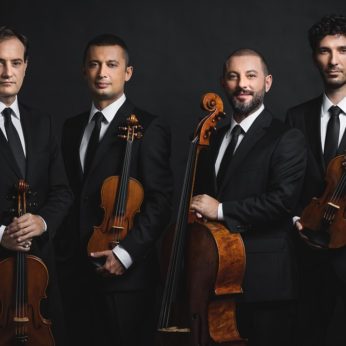Composer: Robert Schumann (b. 1810 - d. 1856)
Performance date: 05/07/2019
Venue: Bantry Library
Composition Year: 1842
Duration: 00:29:24
Recording Engineer: Ciaran Cullen, RTÉ
Instrumentation: 2vn, va, vc
Instrumentation Category:Piano Quartet/Piano Quintet
Artists:
Gloria Campaner -
[piano]
Borusan Quartet (Esen Kıvrak, Özgür Baskin [violins], Efdal Altun [viola], Cağ Ercağ, [cello]) -
[quartet]

Borusan Quartet
Esen Kivrak, Özgür Bask?n [violins]
Efdal Altun [viola], Çag Erçag [cello]
Gloria Campaner [piano]
Robert Schumann [1810-1856]
Piano Quintet in E flat major Op.44 [1842]
1. Allegro brillante
2. In modo d’una marcia, un poco largamente
3. Scherzo, molto vivace
4. Finale – Allegro ma non troppo
Schumann’s early compositions were all for his instrument and those collections of piano pieces were a diary of his emotional life. What mattered was to express his feeling through his music; I believe I have Phantasie and no-one denies it to me. In his youth he had neither the patience nor the application nor the technical skill for extended musical thought. His was the world of Heine and Eichendorff who could crystallise an emotion in four lines of lyric poetry and it is through the miniature that the greatness of these early works is revealed.
These piano years lasted from 1830-40, the last five of these being taken up with his long courtship of Clara against her father’s implacable opposition. When they finally married in 1840, his joy burst out in an extraordinary exuberance of song; I should like to sing myself to death like a nightingale. This was followed by an orchestral year before he turned his attention to chamber music and produced in quick succession the three Op.41 Quartets, the Piano Quintet and Piano Quartet. This was preceded by a systematic study of quartets by Haydn, Mozart and Beethoven. His acquaintance with Mendelssohn’s polished craftsmanship had opened his eyes to his many technical shortcomings.
The Piano Quintet is not only his supreme chamber music achievement but also his happiest reconciliation of the conflicting demands of form and content – youthful fire and a master’s assurance sit easily side by side. He was also the first great composer to combine string quartet and piano, soon to be followed by Brahms and Dvorák. Schumann begins with enormous confidence as if he did not even know the meaning of doubt. This soon melts into disarming lyricism though the extrovert mood of the opening is never far away. The second subject is provocatively sensual, the piano lovingly embraced by the intertwining strings, but it is the strident optimism of Schumann’s opening that seems to dominate the movement.
The opening C minor theme of the slow movement takes the form of a funeral march, whose darkness is relieved by the sweet major key lyricism of the second theme. After the opening theme is repeated in the fashion of a rondo, the violently disturbed central episode is approached by a brief bass-descending motif. The movement ends in a state of deep melancholy. This is speedily banished by the extrovert major key scherzo that is built on the straightforward idea of ascending and descending scales. There are two contrasting trios, the first one soothing, the second even more frantic than the scherzo itself. The finale takes off at the same exhilarating pace and though attempts are made to slow down the hectic chase they have little effect as the movement builds to an emphatic climax. At this climactic moment he crowns the work with a peroration that now combines the main themes from the opening and closing movements in dramatic counterpoint, a brilliant and exciting way of relating the end to the beginning.
Francis Humphrys
Copyright © 2025 West Cork Music. All rights reserved.
Designed and developed by Matrix Internet